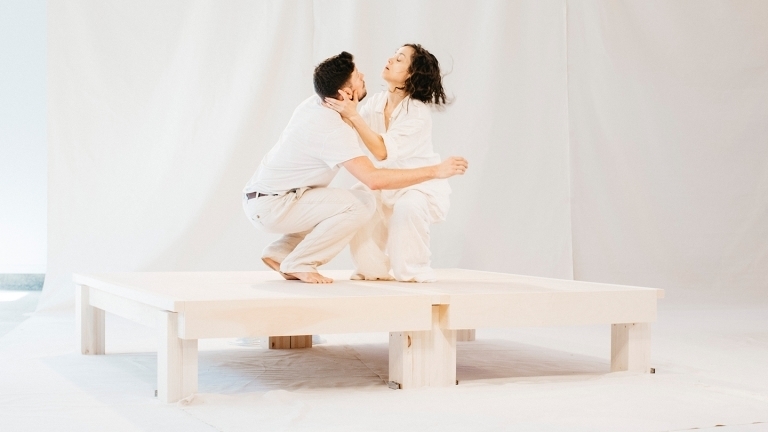Review: LOVE AND OTHER THINGS at Ottawa's National Arts Centre - Rossy Pavillon

From the brief synopsis I read, I knew that this performance would be unlike anything I had ever seen before. This was reinforced by the show's tag line, "Love and Other Things: a drama for flower, clay and bone".
Upon arrival, I was greeted by an usher, who explained how the performance would unfold. The audience would enjoy a pre-show in front of the Rossy Pavilion, in which the main performance was to be held. Once the main event started, we would be invited into the performance space and seated in a semi-circle. Once inside, no one would be permitted to enter or exit the room for the duration of the performance.
The pre-show consisted of five vocalists, barefoot and dressed in back, as well as a "clay puncher", dressed in white robes reminiscent of a toga. Each vocalist was highly talented and, as a group, they performed an array of vocalise melodies. Meanwhile, the clay puncher aggressively attacked the mound of clay, repeatedly smashing it to the floor and pummeling it to submission. The stark contrast between the music and the clay puncher created a juxtaposition between the light and the dark, with the dark being harmonious and the light creating violence. At the end of this segment, the clay puncher brought forth a long piece of white fabric, streaked with red, evoking images of birth and death.
The second part of the performance consisted of three dancers, dressed in white and bearing bouquets of white roses, traditionally a symbol of innocence and purity. Sometimes the dancers were in pairs, sometimes alone, but always moving erratically. Their staggered, jarring, movements felt disconnected from the music, performed by the same vocal artists as in the pre-show. Charles Quevillon, the show's co-director and composer, also moved about the room and created sounds and imagery using various props, including the clay and bone referred to above. Noteably, Quevillon also used a rose, but this single flower was a deep red, a symbol of strong emotion, such as love and desire. As the performance wound down, so did the sun. The pavilion is enclosed in glass, with the setting sun becoming part of the performance. Near the end, Tedd Robinson, the show's co-director and choreographer, made a grandiose appearance, suggestive of a religious figure. Robinson seemed to be outfitted in the same flowing white and red fabric from the finale of the preliminary portion of the show. He was crowned with a pair of sparkling high heels that glowed like a halo.
At the end of the show, I tried to make sense of the experience. A clear storyline was absent, but a series of sounds, coupled with the use of light, texture and discordant movements, created imagery of birth, love, death and rebirth. I was left with the idea that we are born of clay, find life, experience love, and then die, our remnant bones ultimately returning to the earth. This show asks guests to think about what they have seen and derive meaning from the abstract. Another audience member may take something completely different away from the performance, but I invite you to attend a performance and see for yourself.
Love and Other Things runs until Friday, June 1, 2018, at the Rossy Pavilion of the National Arts Centre in Ottawa, Ontario. For more details, please see the National Arts Centre's web site, at https://nac-cna.ca/en/event/19341.
Photo Credit: Maija Tammi
Reader Reviews

Videos


